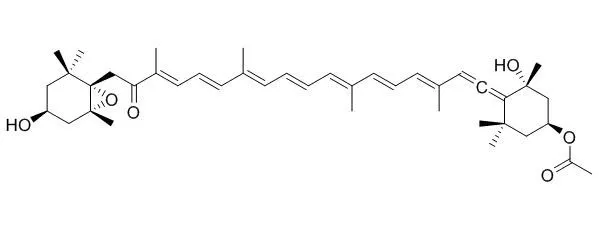| In vitro: |
| J Photochem Photobiol B. 2009 May 4;95(2):101-7. | | Protective effect of fucoxanthin isolated from Sargassum siliquastrum on UV-B induced cell damage.[Pubmed: 19264501 ] | Fucoxanthin is a carotenoid isolated from Sargassum siliquastrum and is considered to be one of major active compound of marine algae.
METHODS AND RESULTS:
In this study, we investigated and confirmed the protective effect of Fucoxanthin on UV-B induced cell injury in human fibroblast via 2',7'-dichlorodihydrofluorescein diacetate (DCFH-DA), 3-(4,5-dimethylthiazol-2-yl)2,5-diphenyltetrazolium bromide (MTT), and comet assays. Intracellular ROS generated by exposure to UV-B radiation, which was significantly decreased by addition with various concentrations of Fucoxanthin. Cell survival rate was increased with Fucoxanthin pre-treated cells, which was reached around 81.47% at 100 microM, and the inhibitory effect of cell damage exhibited dose-dependent manner. Moreover, Fucoxanthin having protective properties was demonstrated via Hoechst 33342/PI staining.
CONCLUSIONS:
Hence, on the basis of the above-mentioned studies, Fucoxanthin has the ability to protect against oxidative stress induced by UV-B radiation and which might be applied to antioxidant and cosmeceutical industries. | | Biochim Biophys Acta. 2004 Nov 18;1675(1-3):113-9. | | Fucoxanthin induces apoptosis and enhances the antiproliferative effect of the PPARgamma ligand, troglitazone, on colon cancer cells.[Pubmed: 15535974 ] |
METHODS AND RESULTS:
The effect of Fucoxanthin, from the edible seaweed Undaria pinnatifida on viability of colon cancer cells and induction of apoptosis was investigated. Fucoxanthin remarkably reduced the viability of human colon cancer cell lines, Caco-2, HT-29 and DLD-1. Furthermore, treatment with Fucoxanthin induced DNA fragmentation, indicating apoptosis. The DNA fragmentation in Caco-2 cells treated with 22.6 microM Fucoxanthin for 24 h was 10-fold higher than in the control. Fucoxanthin suppressed the level of Bcl-2 protein. Also, DNA fragmentation induced by Fucoxanthin was partially inhibited by a caspase inhibitor Z-VAD-fmk. Moreover, combined treatment with 3.8 microM Fucoxanthin and 10 microM troglitazone, which is a specific ligand for peroxisome proliferator-activated receptor (PPAR) gamma, effectively decreased the viability of Caco-2 cells. However, separate treatments with these same concentrations of Fucoxanthin nor troglitazone did not affect cell viability.
CONCLUSIONS:
These findings indicate that Fucoxanthin may act as a chemopreventive and/or chemotherapeutic carotenoid in colon cancer cells by modulating cell viability in combination with troglitazone. |
|
| In vivo: |
| Biochem Biophys Res Commun. 2005 Jul 1;332(2):392-7. | | Fucoxanthin from edible seaweed, Undaria pinnatifida, shows antiobesity effect through UCP1 expression in white adipose tissues.[Pubmed: 15896707] | Mitochondrial uncoupling protein 1 (UCP1) is usually expressed only in brown adipose tissue (BAT) and a key molecule for metabolic thermogenesis to avoid an excess of fat accumulation. However, there is little BAT in adult humans. Therefore, UCP1 expression in tissues other than BAT is expected to reduce abdominal fat.
METHODS AND RESULTS:
Here, we show reduction of abdominal white adipose tissue (WAT) weights in rats and mice by feeding lipids from edible seaweed, Undaria pinnatifida. Clear signals of UCP1 protein and mRNA were detected in WAT of mice fed the Undaria lipids, although there is little expression of UCP1 in WAT of mice fed control diet. The Undaria lipids mainly consisted of glycolipids and seaweed carotenoid, Fucoxanthin. In the Fucoxanthin-fed mice, WAT weight significantly decreased and UCP1 was clearly expressed in the WAT, while there was no difference in WAT weight and little expression of UCP1 in the glycolipids-fed mice.
CONCLUSIONS:
This result indicates that Fucoxanthin upregulates the expression of UCP1 in WAT, which may contribute to reducing WAT weight. |
|






 Cell. 2018 Jan 11;172(1-2):249-261.e12. doi: 10.1016/j.cell.2017.12.019.IF=36.216(2019)
Cell. 2018 Jan 11;172(1-2):249-261.e12. doi: 10.1016/j.cell.2017.12.019.IF=36.216(2019) Cell Metab. 2020 Mar 3;31(3):534-548.e5. doi: 10.1016/j.cmet.2020.01.002.IF=22.415(2019)
Cell Metab. 2020 Mar 3;31(3):534-548.e5. doi: 10.1016/j.cmet.2020.01.002.IF=22.415(2019) Mol Cell. 2017 Nov 16;68(4):673-685.e6. doi: 10.1016/j.molcel.2017.10.022.IF=14.548(2019)
Mol Cell. 2017 Nov 16;68(4):673-685.e6. doi: 10.1016/j.molcel.2017.10.022.IF=14.548(2019)